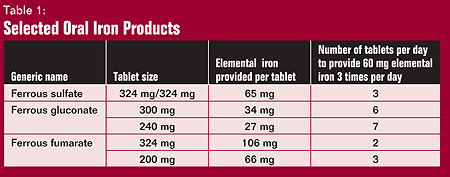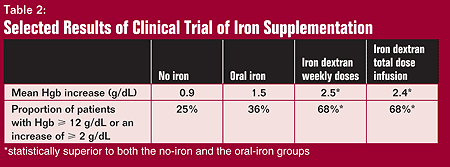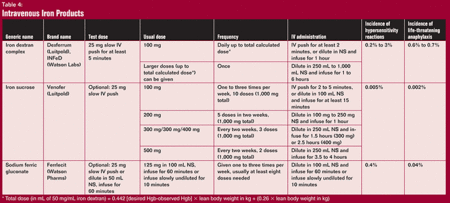Consider iron supplementation with erythropoiesis-stimulating agents
These agents can reduce fatigue and the need for blood transfusions but with associated risks.
Anemia in patients with cancer can be caused by a number of factors including blood loss, hemolysis, nutritional deficiencies, renal insufficiency, marrow infiltration, anemia of chronic disease and myelosuppression from cancer chemotherapy.
|
|
Serious anemia can be treated with blood transfusions, but these are costly and carry risks of transfusion reactions and viral contamination. The erythropoiesis stimulating agents, epoetin alfa (Epogen/Procrit, Amgen) and darbepoetin alfa (Aranesp, Amgen) can increase hemoglobin levels and subsequently reduce fatigue and the need for blood transfusions.
However, new evidence points not only to the thrombotic and cardiovascular risk associated with the use of these agents, but also to the potential for stimulation of tumor growth and reduced survival of cancer patients. New FDA guidelines and CMS reimbursement conditions for the use of these agents include a maximum target hemoglobin of 12 g/dL, acceptable indications, and restrictions on dosage and duration of therapy. When appropriate therapy is initiated, it is important to optimize the effect of the therapy by ensuring adequate patient iron stores.
Most patients treated with an erythropoiesis stimulating agent will develop an actual or functional iron deficiency. A functional iron deficiency is a situation where there are adequate iron stores but they cannot be mobilized adequately to meet the demands of increased erythropoiesis. Iron therapy should be considered, especially among patients whose serum ferritin level is less than 100 ng/mL or the transferrin saturation level is less than 20%.
Oral iron supplementation
Oral iron products are readily available, convenient and many are inexpensive. Table 1 describes a few of the various products available. The usual dose of these products should deliver about 60 mg of elemental iron three times a day. Unfortunately, there is variable oral absorption, and many tablets are required. The adverse effects include nausea, vomiting, and constipation; patient compliance with this therapy can be significantly reduced.

IV iron supplementation
Some researchers have found improved hematologic responses to therapy with erythropoiesis stimulating agents by supplementing patients with IV iron compared to oral iron supplementation. One group of researchers (Auerbach et al, 2004) randomized patients to four arms: IV iron dextran (100 mg weekly), IV iron dextran (single total dose infusion), oral ferrous sulfate 325 mg orally twice a day or no iron supplementation.
All patients received subcutaneous epoetin at 40,000 units weekly, but were not allowed to have transfusions during the study period of at least six weeks. These patients had a variety of nonmyeloid malignancies, with the majority being lung, gastrointestinal and breast cancers.
In this study, compliance in the oral iron group was greater than 90%. The mean baseline ferritin level ranged from 207 pmol/L to 294 pmol/L, and the mean baseline transferring saturation ranged from 14% to 19%. Some results from this study are presented in Table 2.

The authors concluded that IV iron supplementation maximized the hematologic response from epoetin compared to oral iron or no iron supplementation.
In a separate study, other researchers (Henry et al, 2007) compared the hematologic response of epoetin 40,000 units given subcutaneously every week for eight weeks in patients receiving either no iron supplementation, oral ferrous sulfate 325 mg orally three times a day (compliance 93%) or IV ferric gluconate 125 mg weekly.
Most of these patients had lung, breast or colorectal cancers. The mean baseline ferritin level ranged from 321 ng/mL to 388 ng/mL and the mean baseline transferring saturation level ranged from 29% to 36%. Table 3 shows the major results found in this study. These authors concluded that IV ferric gluconate had a greater hematologic effect than no iron or oral iron supplementation.
In both of these studies, the IV iron supplementation supported a greater effect of the epoetin than oral or no-iron supplementation. Furthermore, oral supplementation was only slightly better or no better than no iron supplementation at all.

Adverse effects
Although the IV iron preparations used in these two studies were well tolerated, there is a risk of adverse effects. The most worrisome of these is an anaphylactic-type reaction that begins quickly after initiation of the dose. Hypotension, chest pain, flushing, dyspnea, and respiratory arrest can be seen. This reaction is rare, but potentially very serious.
These reactions have been reported most frequently with iron dextran, but have been rarely seen with iron sucrose or sodium ferric gluconate. Other potential adverse effects include myalgia, arthralgia, pruritis, rash, nausea, vomiting, abdominal pain, fever and back pain.
In summary, iron supplementation is important in optimizing the hematologic effects from erythropoiesis stimulating agents. Parenteral iron therapy appears to be superior to oral iron or no iron supplementation in improving the hemoglobin increase with this therapy.

For more information:
- Lisa K. Lohr, PharmD, BCPS, BCOP, is Clinical Pharmacist in Oncology and Bone Marrow Transplantation in the Department of Pharmacy Services at the University of Minnesota Medical Center, Fairview. She is also the Pharmacology section editor of Hem/Onc Today.
- Auerbach M, Ballard D, Trout JR, et al. Intravenous iron optimizes the response to recombinant human erythropoietin in cancer patients with chemotherapy-related anemia: a multicenter, open-label, randomized trial. J Clin Oncol. 2004;22:1301-1307
- Fishbane S, Kowalski EA. The comparative safety of intravenous iron dextran, iron saccharate, and sodium ferric gluconate. Semin Dial. 2000;13:381-384.
- Henry DH, Dahl NV, Auerbach M, et al. Intravenous ferric gluconate significantly improves response to epoetin alfa vs. oral iron or no iron in anemic patients with cancer receiving chemotherapy. The Oncologist. 2007;12:231-242.
- Silverstein SB, Rodgers GM. Parenteral iron therapy options. Am J Hematol 2004;76:74-78.

